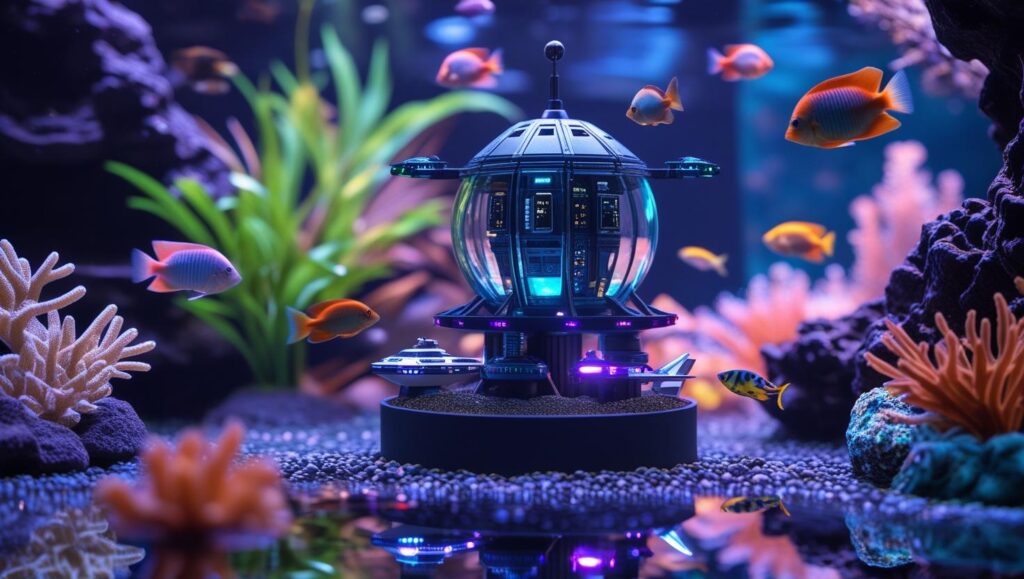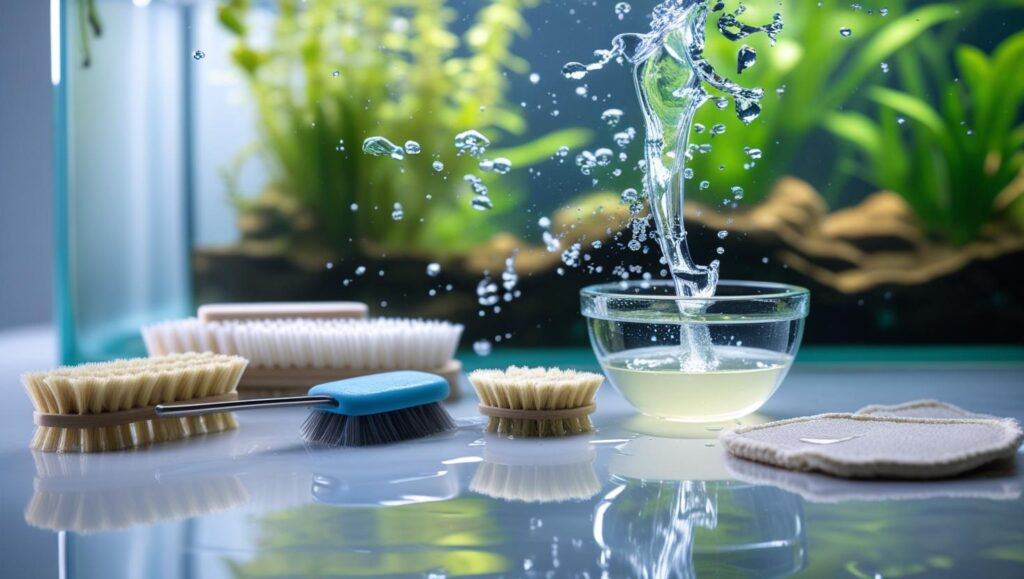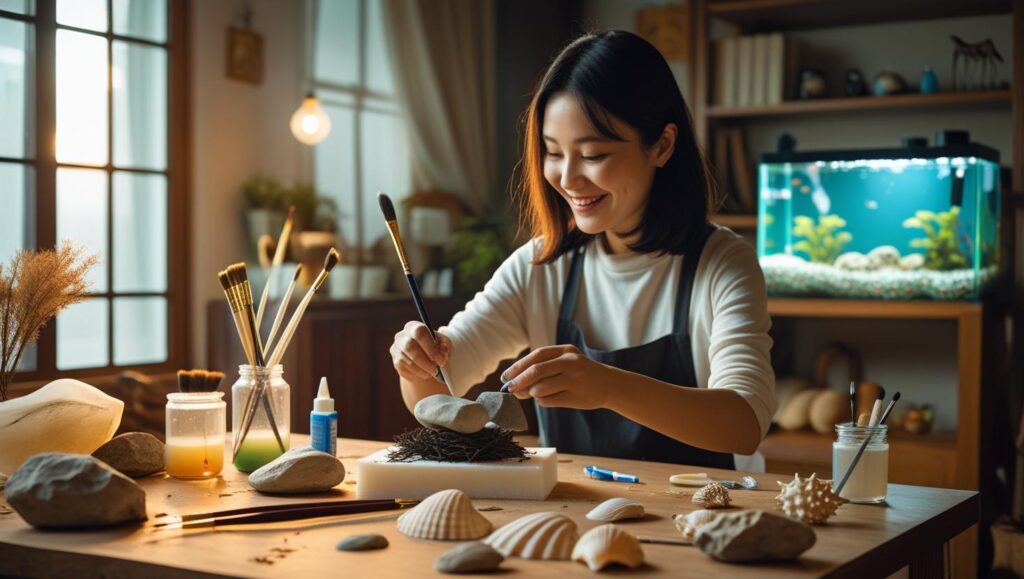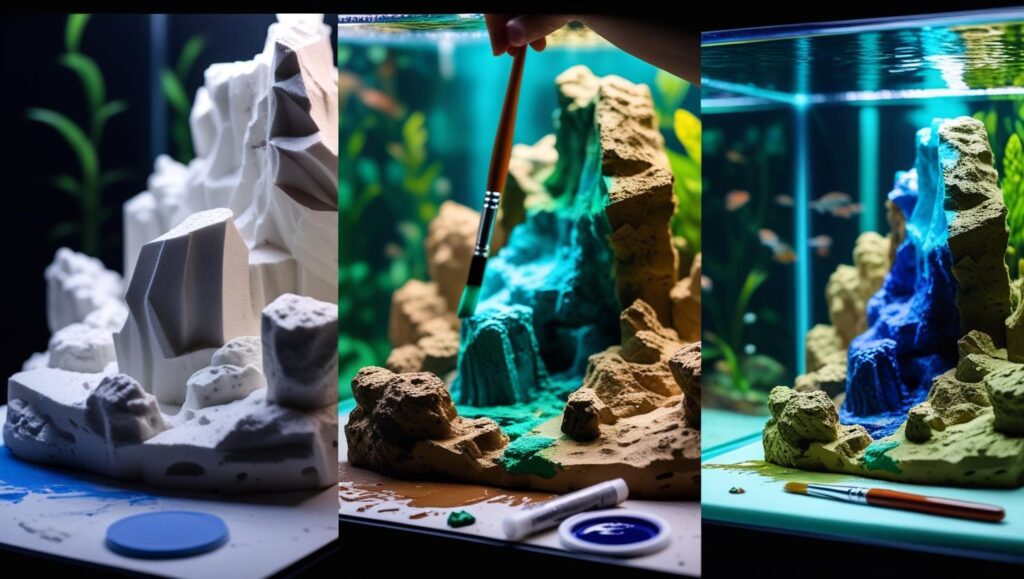The Best Aquarium Wood Decorations: Tips for a Natural Tank
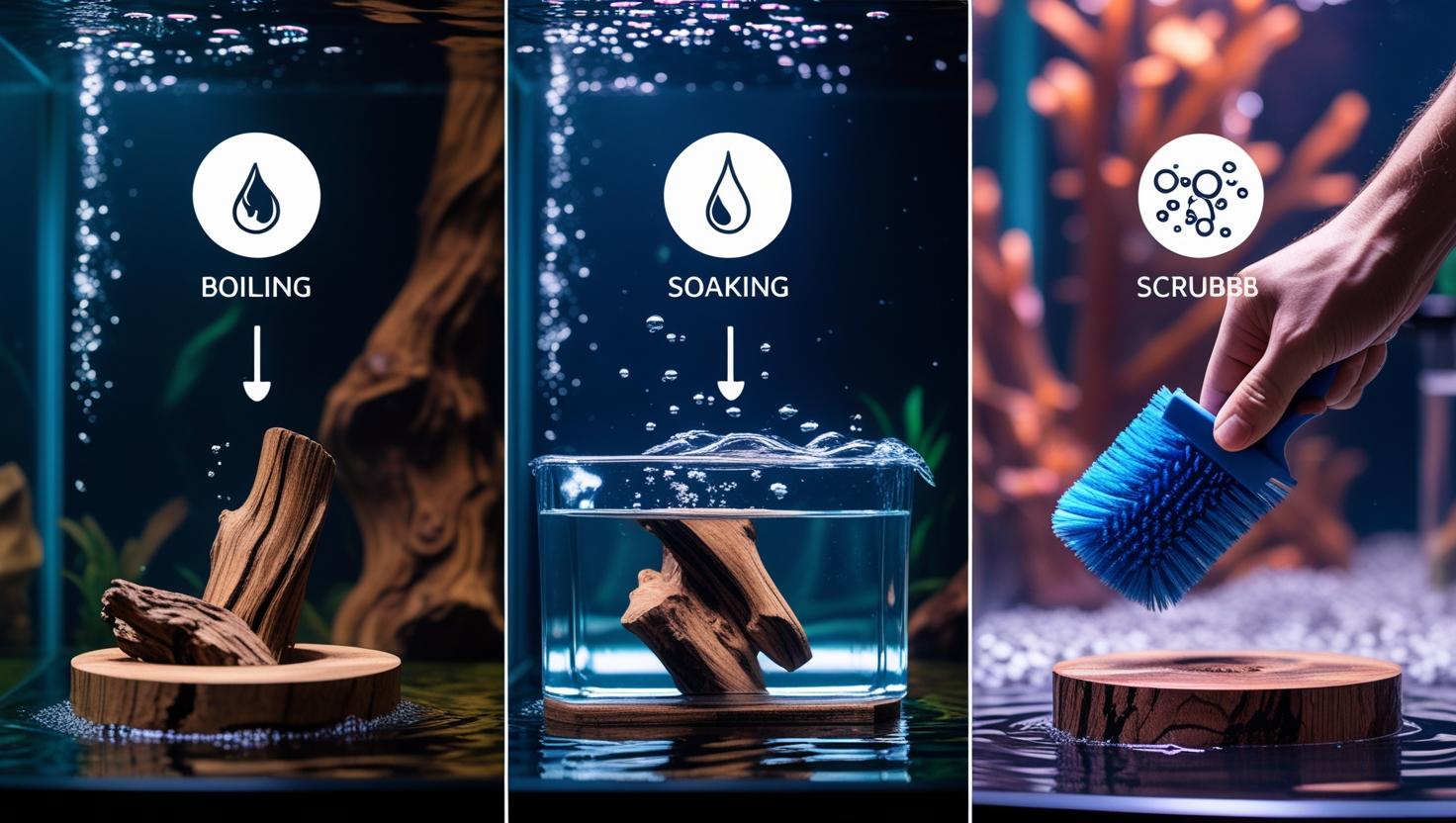
Looking to add a natural touch to your aquarium? Aquarium wood decoration is a fantastic way to bring beauty, function, and a calming vibe to your tank. Whether you’re just starting or looking to spruce up your existing aquarium, natural wood pieces can transform your fish tank design into something truly special.
As an aquarium enthusiast, I remember the first time I set up my own tank and decided to add wood for decoration. It wasn’t just about aesthetics, wood can improve water quality and provide much-needed hiding spots for your fish. In this guide, I’ll share my experience and everything you need to know about using aquarium wood decor in your fish tank, from types of wood to preparation tips and where to buy the best pieces.
What Is Aquarium Wood Decoration?
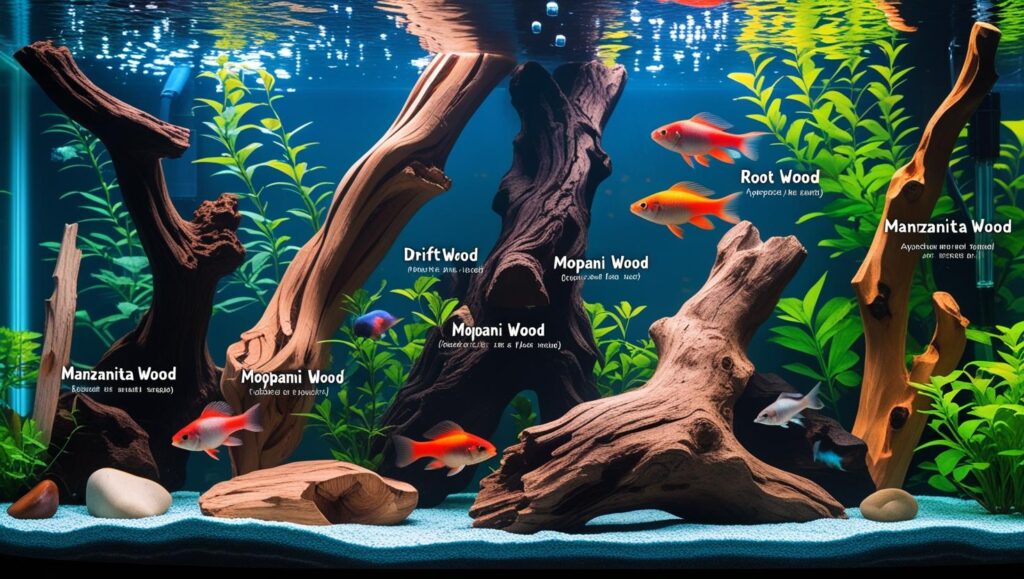
Aquarium wood decoration refers to the use of natural wood pieces or driftwood in a fish tank to enhance its appearance and create a more natural environment. Wood in an aquarium doesn’t just look beautiful—it also provides numerous benefits for both your fish and the overall tank setup.
Common types of aquarium wood include driftwood, root wood, and manzanita wood. These pieces vary in shape, size, and texture, making them versatile for a wide range of aquarium themes. Whether you’re looking for a rustic vibe, an aquascaping masterpiece, or just functional pieces for fish shelters, aquarium wood can do it all.
Example Types of Aquarium Wood Decorations:
- Driftwood for Aquarium: Perfect for creating a natural, aquatic forest look.
- Root Wood: Adds a mysterious, tangled feel to the tank, perfect for hiding spots.
- Aquarium Wood Stand: Elevates your tank’s design by giving your wood a prominent display space.
Why Choose Wood for Aquarium Decoration?
If you’ve ever wondered why people rave about using wood in their aquariums, here are a few reasons why it’s so popular:
1. Adds Natural Beauty
Wood creates a serene, organic aesthetic that artificial decorations just can’t match. The textures and color variations of wood pieces can transform your aquarium into a natural habitat that both you and your fish will appreciate.
2. Enhances Fish Habitats
Wood decorations provide shelter and hiding spots for your fish, especially for more shy species. This helps reduce stress and promotes a healthier environment. For example, fish like bettas and plecos love to hide and explore wooden structures.
3. Improves Water Chemistry
Driftwood releases tannins into the water, which can soften the water and lower pH. This is especially beneficial for species that thrive in slightly acidic water, such as certain types of tetras and discus fish.
4. Provides Hiding Spots for Fish
In addition to adding beauty, wood pieces create natural nooks and crannies where your fish can retreat, rest, or sleep safely. For many species, this is crucial to feel secure in their environment.
What Types of Wood Are Best for Aquarium Decoration?
Now that you understand the benefits, let’s dive into the types of wood you should consider for your aquarium.
1. Driftwood (Best for Larger Tanks)
Driftwood is the go-to choice for many aquarium enthusiasts because of its unique, twisted appearance and versatility. It’s great for larger tanks, as it can be used to create striking focal points or multiple layers in your aquascaping design. It also has a natural ability to soften water, which can be beneficial for certain fish species.
2. Mopani Wood (Good for Aquariums with Plant Setups)
Mopani wood has a beautiful contrast of dark and light wood tones, making it a popular choice for planted aquariums. Its density also means it won’t float once fully submerged. Mopani wood releases tannins into the water, making it great for species that require slightly acidic conditions.
3. Manzanita Wood (Perfect for Aquascaping)
Manzanita wood is ideal for aquascaping because of its striking, gnarled look. It’s a favorite among hobbyists who love to create intricate designs with their tank layouts. This type of wood is durable and tends to sink immediately, eliminating the need for long soaking times.
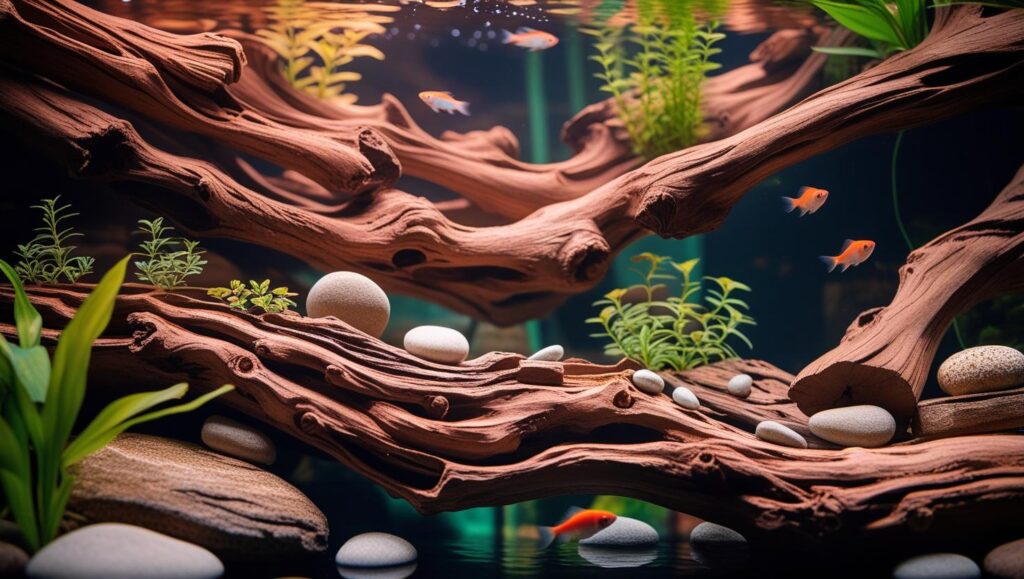
How Do I Prepare Aquarium Wood for Use?
Using wood in your aquarium isn’t as simple as just throwing it in the tank. Proper preparation is key to ensuring your wood is safe and won’t harm your fish.
1. Boiling to Remove Toxins
Some types of wood may contain toxins or resins that can harm aquatic life. It’s important to boil the wood for at least 30 minutes to an hour to remove any potential harmful substances.
2. Soaking to Prevent Floating
Many types of wood, such as driftwood, will float when placed in water. Soaking your wood in a bucket of water for several weeks can help it sink before adding it to your aquarium.
3. Cleaning the Wood
Before placing the wood in your aquarium, be sure to clean it thoroughly. Scrub away any dirt or debris and ensure there are no sharp edges that could harm your fish.
Benefits of Using Aquarium Wood Decoration
Aquarium wood isn’t just for decoration—it comes with a variety of benefits:
- Natural Look: Wood enhances the overall aesthetic of the tank and brings a calming, natural look that your fish will appreciate.
- Water Quality: As mentioned earlier, driftwood releases tannins, which can help soften the water and create a more suitable environment for certain fish.
- Fish Shelter: Wood offers hiding spots and safe spaces for your fish, reducing stress and promoting their health.
- Bacterial Growth: Wood provides a surface area for beneficial bacteria, which helps maintain a healthy and balanced tank ecosystem.
Can Wood Decorations Harm My Aquarium Fish?
While wood is an excellent addition to any aquarium, it can harm your fish if not properly prepared. For example, some types of wood contain harmful substances that can leach into the water. However, when cleaned, boiled, and soaked properly, aquarium wood is completely safe.
Safety Tips:
- Always rinse the wood thoroughly before placing it in your tank.
- Check for sharp edges to avoid injuring your fish.
- Ensure the wood is aquarium-safe, as some woods can be toxic to fish (e.g., pine or cedar).
Where to Buy Aquarium Wood Decorations?
Finding the right aquarium wood is essential for achieving the look and functionality you desire in your tank. Here are some top options for purchasing aquarium wood:
1. Local Pet Stores
Many pet stores carry a selection of aquarium wood decorations, so you can see them in person before buying.
2. Online Retailers
Websites like Amazon, Petco, and specialty aquarium shops offer a wide range of wood options. When buying online, be sure to read customer reviews to ensure the quality of the product.
3. Specialty Aquarium Shops
These shops usually have a more extensive collection of aquarium wood, including rare and unique pieces for more specialized tanks.
How to Style Your Aquarium with Wood Decorations
Once you’ve selected your aquarium wood, the next step is figuring out how to style it in your tank. Whether you’re going for an aquascaping masterpiece or simply want to create a natural habitat for your fish, the way you position the wood can make a huge difference.
1. Create a Focal Point
If you have a large piece of driftwood, you can use it as a centerpiece to draw the eye. Position it at the back of the aquarium or slightly off-center for a balanced, striking look. This helps create depth and a focal point in your aquarium.
2. Build a Forest-like Look
For a more natural, forested vibe, scatter multiple pieces of wood around your tank. Use smaller branches or twigs in addition to larger driftwood pieces to give the illusion of a dense underwater forest. You can also use plants like Java ferns or moss to grow on the wood, enhancing the natural look.
3. Incorporate Caves and Tunnels
Wood pieces like root wood or manzanita can be arranged to create tunnels or caves for your fish to swim through. This is especially important for species that love to hide or need a safe space. Positioning the wood this way not only adds functionality but also gives the fish more room to explore.
4. Layering with Rocks and Gravel
Combining wood with rocks and gravel can create a more structured aquascape. The wood pieces can be placed over a bed of gravel or rock formations to create an environment that mimics a natural stream or riverbed. This layering also helps provide different areas for beneficial bacteria to thrive.
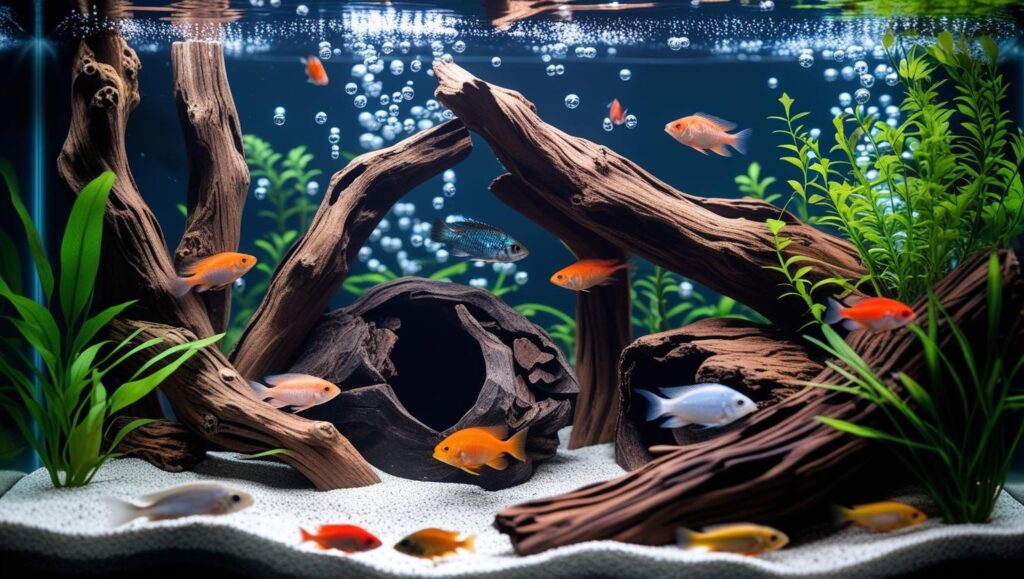
How Long Does Wood Last in an Aquarium?
Wood can last a long time in an aquarium, but its lifespan can depend on a few factors. Here’s what you need to know:
1. Type of Wood
Some woods, like Mopani and Manzanita, are denser and more durable, meaning they can last for many years without breaking down. On the other hand, softer woods might degrade more quickly, especially if the tank has high water flow or if the wood isn’t properly prepared.
2. Water Conditions
Water parameters such as pH, temperature, and hardness can affect the longevity of the wood. For instance, wood may break down faster in soft water due to higher acidity. However, when maintained correctly, wood can serve as a long-lasting decoration in your aquarium.
3. Regular Maintenance
To extend the life of your aquarium wood, perform regular maintenance, such as cleaning off algae buildup and ensuring the wood is still structurally sound. If you notice it breaking down or affecting water quality, it may be time to replace it.
The Aesthetic Benefits of Aquarium Wood
Wood in your aquarium doesn’t just offer functional advantages; it also contributes significantly to the aesthetic appeal of your tank. Here’s why it’s a must-have for aquascaping:
1. Creates Depth and Texture
Aquarium wood introduces different textures that create visual interest. Smooth driftwood contrasts beautifully with the fine details of plant roots or other substrate materials, making your aquarium feel more dynamic.
2. Natural Color Palette
The rich, earthy tones of wood complement the vibrant colors of your fish and plants. The neutral browns, grays, and tans of wood don’t overpower the other elements in your tank but instead enhance the natural beauty of the environment. These colors are especially pleasing to the eye and contribute to a relaxing, peaceful atmosphere.
3. A Timeless, Rustic Look
No matter the style of your aquarium, wood brings a timeless, rustic charm. Whether you’re aiming for a minimalist design or a lush aquascape, wood works beautifully in any setup. It adds character and a touch of nature to your aquarium, making it a space you’ll enjoy for years.
Can Aquarium Wood Improve Fish Behavior?
While the aesthetic and functional benefits of aquarium wood are clear, there’s also evidence that wood can positively impact your fish’s behavior. Here’s how:
1. Reduces Stress
Fish are less stressed when they have hiding spots and places to explore. Wood provides natural shelters where fish can retreat, which helps reduce territorial disputes and calms more nervous species. This can result in healthier fish with fewer behavioral problems.
2. Encourages Natural Behavior
In the wild, fish often seek shelter and explore structures like wood. Providing similar features in your aquarium allows them to exhibit more natural behaviors, such as foraging, swimming through tunnels, or interacting with their environment in more complex ways.
3. Prevents Aggression
Many species, such as cichlids, can become territorial, especially in crowded tanks. Adding wood gives them a sense of security and can help reduce aggressive behaviors. Wood can create natural barriers between territories, minimising conflicts between fish.
Tips for Maintaining Your Aquarium Wood
Proper maintenance of your aquarium wood will keep it looking great and functioning well for years. Here are some tips to ensure your wood stays in tip-top shape:
1. Regular Cleaning
Every few weeks, scrub your wood to remove algae and biofilm buildup. A soft brush can be used to avoid damaging the surface. Just be sure not to scrub too harshly, as this can cause the wood to splinter.
2. Monitor Water Quality
Keep an eye on the water parameters, especially the pH, to make sure the tannins released from the wood aren’t impacting the water quality negatively. Regular water changes will help maintain a healthy environment for both your fish and the wood.
3. Replace Damaged Wood
While aquarium wood can last a long time, it can eventually break down or degrade. If you notice your wood is deteriorating, affecting water quality, or no longer looks good, replace it with a new piece to keep your tank looking its best.
Final Thoughts on Aquarium Wood Decoration
When it comes to decorating your aquarium, wood is an exceptional material that offers both beauty and function. Whether you’re enhancing the tank’s aesthetic, providing hiding spots for your fish, or improving water chemistry, wood plays a vital role in creating a thriving aquarium ecosystem.
Adding wood to your tank isn’t just about creating a beautiful display; it’s about enhancing the well-being of your fish and improving the overall health of your tank. As you plan your next aquarium decoration, I encourage you to consider the unique benefits of aquarium wood decoration, it’s a natural, sustainable, and visually stunning choice.
From my experience, once I incorporated wood into my aquarium, it truly felt like my tank came to life. It gave my fish the shelter they needed and transformed the tank into a calming aquatic environment. If you haven’t yet considered aquarium wood for your tank, give it a try; you won’t regret it!

